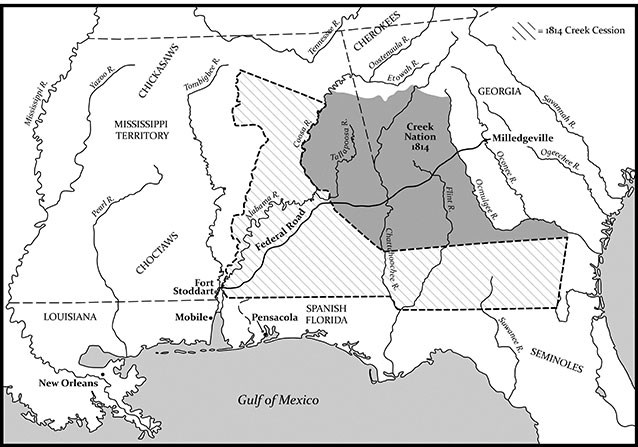Last updated: November 30, 2022
Article
Summer 1814: The Treaty of Ft. Jackson ends the Creek War
The Treaty of Fort Jackson ended the fighting of the Creek War, but began a series of negotiations between the Creek community and the U.S. Government for land, property, and monetary resources.
Under the terms of the treaty, the Creek Nation ceded nearly 22 million acres to the United States. Jackson justified the seizure of so much territory as payment for the expense of an “unprovoked, inhuman, and sanguinary” war.

The Treaty of Fort Jackson (August 9, 1814) ended the Creek War. Andrew Jackson served as the sole representative of the United States and dictated the terms, assisted by Benjamin Hawkins, the long-serving federal agent to the Creeks. Although styled as a military capitulation, the treaty was actually made with the Creek National Council, an American ally. The proceedings represented 28 Creek towns.
Under the terms of the treaty, the Creek Nation ceded nearly 22 million acres to the United States. Jackson justified the seizure of so much territory as payment for the expense of an “unprovoked, inhuman, and sanguinary” war. When Jackson’s Creek allies pointed out that only a faction of the Creek Nation had attacked Americans, Jackson replied that they were still responsible for their failure to prevent the Red Stick attacks. The majority of the land taken lay west of the Coosa River, which became the new western boundary of the Creek Nation, and along the Alabama River, thereby opening up a transportation artery between Tennessee and the gulf coast, and securing valuable land for American settlers. According to Article 1 of the treaty, allied Creek headmen whose property lay within the cession were given the opportunity to apply for private reservations of one square mile. A limited number were able to obtain private title to their improvements in the ceded territory.
The Creeks protested that some of the ceded land was specifically claimed by towns that had remained “friendly” to the United States. This land, along the Creek-Florida border, was taken by Jackson to establish an American buffer zone between the Creeks and Spanish Florida. After Jackson forced the Creek leadership to agree to the cession, the Creek Nation persisted in pressing for compensation for this southern territory for generations. In 1962, the Indian Claims Commission authorized a payment of nearly four million dollars for the disputed tract of nearly nine million acres.
The treaty required the Creeks to break off all communication with Spanish Florida and Great Britain, severing Creek claims to lands they had traditionally claimed in the Florida peninsula. The treaty also gave the United States the right to establish military posts, trading houses and roads across Creek territory, guaranteeing free navigation of all rivers for American citizens. All Creeks who fought against the United States were to surrender, and the Creek leadership was to assist in restoring all property, including slaves and horses, Red Stick Creeks captured from American citizens during the war. In return, the United States promised to provide food rations to the displaced and starving population of the Upper Creek towns.
Although the treaty did not address the property losses of allied Creeks, prior to beginning of treaty negotiations the war department had indicated that Creek claims for losses for personal property destroyed by Red Sticks would be honored. After signing the treaty, the Creeks submitted their claims for lost property, including destroyed structures, livestock, and personal property, as well as captured slaves and horses. The secretary of war ultimately decided to honor these claims, which totaled more than $300,000, but this final amount was never paid in full. Individuals continued to petition for the balances owned to them, with limited success. Those who had opposed the National Council and fought the United States received no compensation for their losses.
